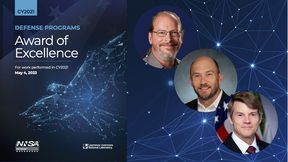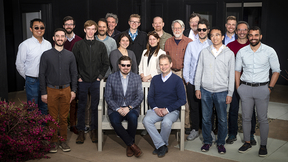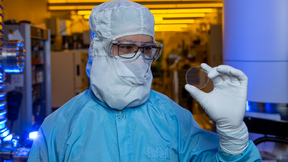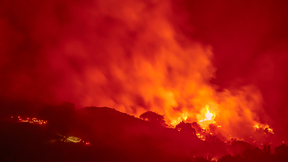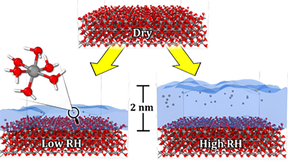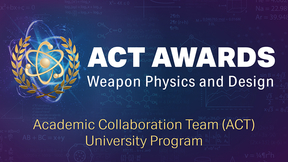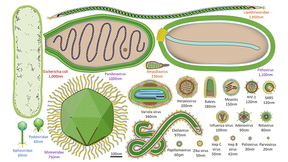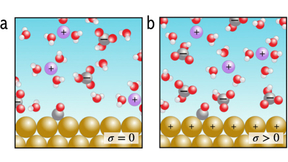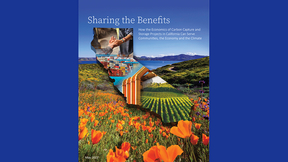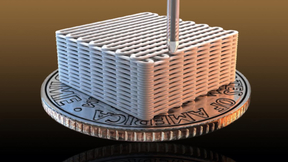Back
In virtual ceremonies held May 4 and June 26, Marvin Adams, deputy administrator for Defense Programs at the National Nuclear Security Administration (NNSA), honored individuals and teams at Lawrence Livermore National Laboratory (LLNL) and partner sites for their outstanding contributions to nuclear security. The Defense Programs Awards of Excellence recognition events…
To learn about the properties of materials under changing temperatures and pressures, researchers typically combine laboratory experiments with theoretical models and computer simulations. It’s an iterative process: The models help in designing the experiments and interpreting the results, and the results “constrain,” or fine-tune, the models so they can effectively guide…
An international collaboration of researchers from Lawrence Livermore National Laboratory (LLNL) and other scientific institutions is ramping up its studies into “sterile neutrinos” to discover and better understand dark matter. Sterile neutrinos are theoretically predicted new particles that offer an intriguing possibility in the quest for understanding the dark matter in…
Optics researchers at Lawrence Livermore National Laboratory (LLNL) have refined their novel metasurface process to create taller features without increasing feature-to-feature spacing, an advance that unlocks exciting new design possibilities. “We have refined our process to create metasurfaces that allow for a wide optical bandwidth and a large span of incidence angles…
Summer wildfire seasons in California routinely break records. The average summer burn area in forests in northern and central portions of the state have increased fivefold between 1996 and 2021 compared to between 1971 and 1995. Although the drivers of increased temperature and dryness are known, the contribution of human-caused climate change to wildfire activity,…
Scientists at Lawrence Livermore National Laboratory (LLNL) performed simulations using the Lab's supercomputer Ruby to uncover physical mechanisms that explain why humidity controls the rate of atmospheric corrosion of aluminum metal. Their research is featured in the ACS Journal of Applied Materials and Interfaces. Accurate predictions of aluminum component lifetimes…
Six scientists at Lawrence Livermore National Laboratory were recently granted awards through the Lab's 2022 Academic Collaboration Team (ACT) annual call for proposals. Now in their fourth year, ACT university collaboration awards were created to encourage and advance strategic partnerships among universities with a focus on the Lab’s and Weapons and Complex Integration’s…
Cropland management practices that restore soil organic carbon (SOC) are often looked at as climate solutions that also enhance yields. But how often these benefits align at the farm level — the scale of farmers’ decision-making — remains unclear. In a new study in Nature Sustainability, a Lawrence Livermore National Laboratory (LLNL) scientist and collaborators examined…
Lizz Lantz has always been driven by curiosity about how the world works. “I’m really interested in the materials that make up the world around us, which we often take for granted,” Lizz Lantz said. “And, what better way to explore the world’s fabric than to inspect it under the microscope?” Lizz Lantz exercises this interest in her position as a metallography technician…
Three graduate students have earned Department of Energy Office of Science Graduate Student Research (SCGSR) Program awards to perform their doctoral dissertation research at Lawrence Livermore National Laboratory (LLNL). They are three among the 87 graduate students representing 33 states for the SCGSR program’s 2022 Solicitation 2 cycle. Through world-class training and…
On Earth, viruses are abundant and an integral part of life. However, very little is known about them outside human health contexts, especially in areas related to space. Understanding the role viruses play on Earth and how they interact with their hosts in extreme environments can better inform human spaceflight missions (environmental control, life support systems, and…
One of the fundamental challenges in computational modeling is to balance the trade-off between the length and time scales that need to be simulated and the corresponding computational costs. Relevant time scales are typically determined by a phenomena of interest, e.g., a protein’s activation or a chemical reaction, whereas length scales are usually chosen based on the…
In solidification processing, such as casting, welding, or additive manufacturing, cellular or dendritic patterns develop during the growth of a solid crystal from the liquid phase. In metallurgy, each similarly patterned region is referred to as a grain—which must be controlled during processing as grains affect structural performance. Additionally, the grain texture—the…
Copper-based catalysts are highly active for electrochemical reduction of CO2 (CO2R) to several desirable hydrocarbon products, such as methane (CH4), formic acid (HCOOH), ethylene (C2H4), and ethanol (C2H5OH). CO2R is dually beneficial, as it allows for the conversion of excess atmospheric CO2 into useful chemicals. However, using copper-based catalysts for CO2R depends…
A new report co-authored by George Peridas of the Lawrence Livermore National Laboratory (LLNL) and Benjamin Grove of the Clean Air Task Force examines the economic viability of carbon capture and storage (CCS) projects in California and finds that several classes of projects are viable today. These can help the state meet its climate goals and hold a sizable potential to…
Scientists have conducted laboratory experiments at Lawrence Livermore National Laboratory (LLNL) that provide new insights on the complex process of pressure-driven ionization in giant planets and stars. Their research, published today in Nature, unveils the material properties and behavior of matter under extreme compression, offering important implications for…
A Lawrence Livermore National Laboratory (LLNL)-developed technology known as Energy Inks has won a best in region award for the Far West region from the Federal Laboratory Consortium for Technology Transfer (FLC). This is the technology’s second award in the past nine months, as it received an R&D 100 award last September as one of the top 100 industrial inventions in…
Lawrence Livermore National Laboratory (LLNL) and University of California, Davis researchers are assisting Arizona State University with a new laser facility that will use ultrafast pulsed X-ray beams to study biological processes, materials and other research at the atomic level. In March, the National Science Foundation announced that it was awarding $90.8 million to…
New research shows that it is now virtually impossible for natural causes to explain satellite-measured changes in the thermal structure of Earth’s atmosphere. The analysis conducted by Lawrence Livermore National Laboratory (LLNL) scientists and colleagues for the first time demonstrates that extending “fingerprinting” techniques — used to identify the human effects on…
Carbonate minerals are formed when carbon dioxide reacts with magnesium and calcium-rich rocks. But where does that CO2 come from? If it comes from the atmosphere, this process at sufficient scale may be able to reliably draw down atmospheric greenhouse gas levels, according to new research by Lawrence Livermore National Laboratory (LLNL) scientists. The research appears…

